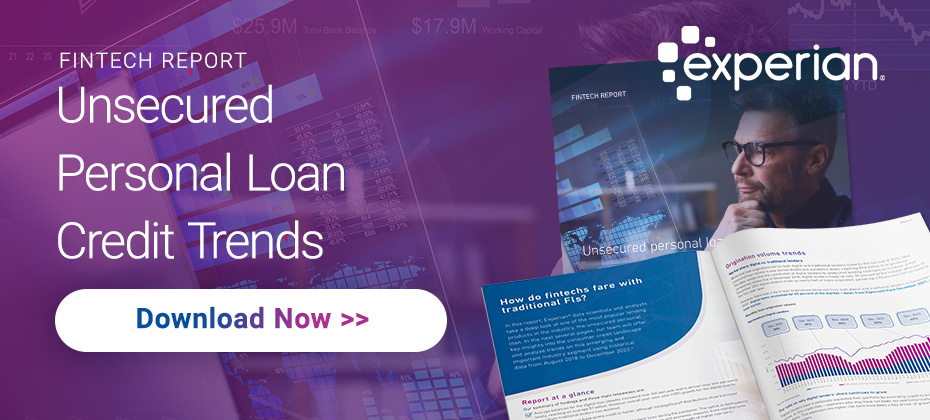Tag: consumer credit trends

In today's fast-paced financial landscape, consumer expectations are higher than ever. Financial institutions must rethink their strategies to stay ahead of rising interest rates, intense competition, and the need to innovate constantly. To thrive, it’s not just about offering the best rates—it's about building deeper, more meaningful relationships with customers and delivering personalized, proactive value that drives loyalty and growth.

The unsecured personal loan, one of the most popular products in the financial space, has seen ebbs and flows over the last several years due to many factors, including economic volatility, the global pandemic, changing consumer behaviors and expectations, and more. Experian data scientists and analysts took a deep dive into data between 2018 and 2022 to uncover and analyze trends in this important industry segment. Additionally, they recommend fintech lending solutions to help fintechs stay ahead of ever-changing market conditions and discover new opportunities. This analysis shows that digital loans accounted for 45 percent of the market in 2022. While this is down from 52% in 2021, digital loan market share continues to grow. The analysis also provides a detailed look into who the digital borrower is and how they compare to traditional borrowers. As we look to the rest of 2023 and beyond, fintechs must be armed with the best digital lending technology, tools, and data to fuel profitable growth while mitigating as much risk as possible. Download our fintech trends report for a full analysis on origination volume trends, delinquency trends, and consumer behavior insights. Download now

Believe it or not, 2023 is underway, and the new year could prove to be a challenging one for apartment operators in certain ways. In 2021 and into the beginning of 2022, demand for apartment rentals approached record levels, which shrunk vacancy rates and increased monthly rents. The rest of the year remained stagnant while other regions saw some decline, but inflation and other economic factors have many apartment communities confronted with labor shortages, and other challenges which can certainly make leasing and operating properties difficult. Against that backdrop, here are some of the technologies and solutions operators should consider for optimizing their success and efficiencies in 2023 and beyond. Tools that allow prospective residents to have a fully digital and contactless leasing experience — During the pandemic, many operators rushed to implement virtual tours, onsite self-guided tours and other solutions that allowed prospects to apply for and finalize their leases remotely. Prospective renters have undoubtedly grown fond of navigating the leasing process from their homes and taking self-guided tours when onsite, and the demand for digital solutions will surely continue even after COVID distancing is no longer a factor. Therefore, apartment owners and operators should think of these capabilities as long-term investments and always seek ways to optimize the digital leasing experience they provide. Along those lines, forward-thinking operators are employing solutions that allow them to embed credit functionality into their websites and mobile apps using modern, RESTful APIs like the Experian ConnectSM API. Not only does it enhance the information included in a lease application with credit report data, but it also allows prospective renters to easily apply for more than one property at once, enhancing their experience at the same time. Automated lease application form fill — By using information entered by a lease applicant (such as first name, last name, postal code and the last four digits of a Social Security number), this technology uses information from credit files to automatically fill other data fields in a lease application. This tool reduces the effort required by prospective renters to complete the application process, resulting in a better user experience, faster completions, greater accuracy and reduced application abandonment. Automated verification of income, assets, and employment — These solutions eliminate the need for associates to manually verify these components of a lease application. Manual verification is both time-consuming and prone to human error. In addition, automated tools eliminate the opportunity for applicants to supply falsified supporting documentation. The best part about verification is the variety of options available; leasing managers can pick and choose verification options that meet their needs. Renter Risk Score™ and custom-built scores and models applying RentBureau data — These options offer a score designed expressly to predict the likelihood that an applicant will pay rent. Renter risk score can be purchased with preset score logic, or for high-volume decisions, a model can be built calibrated for your specific leasing decisioning needs. A rental payment history report — The RentBureau Consumer Profile tool can provide detailed insight into a lease applicant's history of meeting their lease obligations, which is invaluable information during the lease application process. Having a tool to report rental payment histories to credit bureaus can be a powerful financial amenity. By reporting these payments, operators can help residents build credit histories and improve financial well-being. Such an amenity can attract and retain residents and provide them with a powerful incentive to pay rent on time and in full. In the end, tools that seek to manage risk and create improved experiences for prospective renters have a multitude of benefits. They create meaningful efficiencies for onsite staff by greatly reducing the time, resources and paperwork required to process applications and verify applicant information. This gives overextended associates more time to handle their many other responsibilities. Beyond just efficiency savings, these technologies and solutions also can help operators avoid the complications and loss of income that result from evictions. In fact, the National Association of Realtors estimates that average eviction costs $7,685. Managing risk and providing the best possible customer experience should always be top of mind for rental housing operators. And with the solutions outlined above, they can effectively accomplish those goals in 2023 and beyond.

The collections landscape is changing due to shifting consumer behaviors, demands, regulations and an economy that’s in a constant state of flux. As the market evolves, the need for greater insight and analysis grows. Matthew Baltzer, Experian’s Senior Director of Product Marketing, discusses challenges facing the collections industry and how you can continue to build a profitable portfolio. For more information on enhancing your collections strategy, view our full Q&A video. Q: Which macroeconomic trends should debt collectors be the most aware of and why? A:While we are still seeing a reasonably healthy consumer, there are trends to monitor. The first would be employment, which continues to be strong. Laid-off individuals are typically able to move back into the labor force. Second, we're seeing strong consumer spending, with rates higher than in the past three years and high origination activity. A third is declining savings rates. During the pandemic, consumers stored away extra cash, which has since come to a halt. Part of that is likely due to inflation, but it could also point to signs of financial strain. Q: How could these trends impact debt collections strategies moving forward? A: At a portfolio level, they’re good news. The average consumer’s ability to pay has yet to degrade significantly. So, collectors should be able to continue collecting payments. However, six months from now, the impact of inflation and interest rates could take a toll, and settlement offers, or higher upfront payments, may be important tools to consider. Due to increasing interest rates, many households will send money to creditors, leaving less for everyday spending. Q: How has the average consumer been affected by inflation? A: As I mentioned, both consumer spending and overall debt are up. However, when it comes to spending, certain ‘categories’ are more impacted by inflation than others. Of course, home equity and mortgages are higher, which while important, is less impactful for debt collectors. In our recent webinar, ‘Economic Outlook and the Influence on Debt Collections,’ we highlighted the uneven impact inflation has on lower earners in categories such as rent, food and energy. Due to this, collectors may see a rise in delinquency rates, particularly in unsecured personal loans and potentially automotive loans. Q: How should consumers' response to inflation impact collections efforts? A: There may be an increase in opportunities in certain trades, such as utilities, automotive and unsecured personal loans. Are you positioned as an organization to target and serve those markets? For those in the industry, the real potential for an economic weakness should present an opportunity to evaluate your collection strategy. How will you adapt to a 20 to 30% increase in volume? What about working accounts with smaller balances, which we've seen more of since the last larger recession? Experian offers software and decisioning solutions that help debt collectors optimize their strategies for an improved return on investment. Q: What consumer specific data can help lenders better predict distressed consumers? A: As an originator, the first approach to consider should be leveraging new types of data that were not available during the last recession, such as trended, third-party and alternative credit data. Supplementary data can provide leading indicators that risk is increasing before a consumer goes delinquent and their accounts are past due. Additionally, advanced analytics scoring models can help you determine which accounts are more likely to be recoverable. Experian has a new scoring model that uses a complex blend of attributes to assess each trade's history and position in wallet to better predict the likelihood of that account self-curing and separate accounts that need the most attention from those that may need more time. Finally, with accurate consumer contact data, you can enhance your digital engagement strategy and reach the right person, at the right time, on the channel they prefer There’s no time like the present to equip yourself with a successful debt management strategy. With a more holistic consumer view, you can improve account prioritization, predictability and right-party contact rates. Learn more about our debt management solutions here. Watch on-demand webinar

Whether your goal is to gain new business or create cross-sell opportunities, being proactive in your credit marketing approach can help drive higher response rates and more meaningful customer experiences. But without knowing when your ideal customers are actively seeking credit, you may risk losing business to lenders who have already engaged. So, how can you identify new opportunities when they occur? Given that 91% of consumers say they’re more likely to shop with brands that provide relevant offers, you’ll need to reach the right consumers at the right moment to increase response rates and stay ahead of competitors. Event-based credit triggers can help you identify new tradelines, inquiries and certain loans nearing term to locate highly responsive, credit-active individuals. By receiving updates on consumers’ recent credit activities, you can make firm credit offers immediately so you never miss an opportunity. Case Study: Deliver timely offers with credit trigger leads Vantage West Credit Union serves over 170,000 members across Arizona. With their members looking elsewhere for their mortgage needs, Vantage West aimed to drive as many of these members back to the credit union as possible. To do this, they looked for a solution that could help them identify and target members who are in the market for a new mortgage. By augmenting their prescreen process with Experian’s Prospect Triggers for mortgages, the credit union was able to quickly pinpoint consumers that not only met their credit criteria but were also likely to respond to their credit offers. Within two years of implementing Prospect Triggers, Vantage West funded an additional $18 million in mortgages and is continuing to grow by making timely offers to credit-active prospects. Prospect Triggers is available for banks, credit card issuers, mortgage lenders, retailers and automotive lenders. To learn how Experian can help bring precision and profitability to your credit marketing campaigns, read the full case study or visit us. Download the case study Visit us

According to Experian’s State of the Automotive Finance Market Report: Q2 2022, the average new vehicle interest loan rate for consumers with a credit score between 501 and 600, also referred to as subprime, was 9.75%—compared to prime consumers with a credit score between 661 and 780, who had an average new vehicle interest loan rate of 4.03% this quarter.

According to Experian’s State of the Automotive Finance Market Report: Q1 2022, credit unions had their highest total share in five years

As more consumers apply for credit and increase their spending1, lenders and financial institutions have an opportunity to expand their portfolios and improve profitability. The challenge is ensuring they’re extending credit responsibly and inclusively. Millions of Americans, many of whom are creditworthy, lack access to mainstream credit options. This may be because they have limited or no credit history, negative information within their credit file, or are a part of a historically disadvantaged group. To say “yes” to consumers they otherwise couldn’t or wouldn’t lend to, lenders must gain a deeper understanding of an individual’s stability, ability and willingness to pay. That’s where expanded FCRA-regulated and trended data come in. While traditional credit data has long been the primary means of gauging creditworthiness, it doesn’t tell the full story of a consumer’s financial situation. Let’s explore how differentiated data can help lenders make more informed credit decisions. Using differentiated data for deeper lending Expanded FCRA-regulated data provides supplemental credit data to help lenders gain a more holistic view of their current and prospective customers. Some examples of expanded FCRA-regulated data include alternative financial services data from nontraditional lenders, consumer-permissioned account data, rental payments and full-file public records. Because this data drives greater visibility and transparency around inquiry and payment behaviors, lenders can more accurately determine a consumer’s ability to pay and distinguish between reliable and high-risk applicants. In turn, lenders can approve more creditworthy consumers, grow their portfolios and increase financial opportunities for underserved communities, all while preventing and mitigating risk. 89% of lenders agree that expanded FCRA-regulated data allows them to extend credit to more consumers. Trended data empowers lenders with predictive insights into consumers by providing key balance and payment data for the previous 24 months. This is important as lenders can determine if a consumer’s credit behavior has improved or deteriorated over time. In turn, lenders can: Identify creditworthy customers: Establish if a consumer has a demonstrated ability to pay, is consistently paying more than the minimum payment, or shows no signs of payment stress. Increase response rates: Match the right products with the right prospects. Determine upsell and cross-sell opportunities: Present relevant offers based on anticipated needs and behaviors. Limit loss exposure: Understand the direction and velocity of payment performance to effectively manage risk exposure. Trended data helps lenders better predict future behavior, manage portfolio risk and design the best marketing offers. Turning insights into action Together, trended and expanded FCRA-regulated data benefit lenders and consumers alike. With a more holistic view of their customers, lenders gain powerful insights to lend deeper, ultimately helping them to expand their portfolios and drive greater access to credit for underserved communities. Learn more 1 The Recovery of Credit Applications to Pre-Pandemic Levels, Consumer Financial Protection Bureau, 2021.

Credit plays a vital role in the lives of consumers and helps them meet important milestones – like getting a car and buying their own home. Unfortunately, not every creditworthy individual has equal access to financial services. In fact, 28 million adult Americans are credit invisible and another 21 million are considered unscorable.1 By leveraging expanded data sources, you can gain a more complete view of creditworthiness, make better decisions and empower consumers to more easily access financial opportunities. The state of credit access Credit is part of your financial power and helps you get the things you need. So, why are certain consumers excluded from the credit economy? There’s a host of reasons. They might have limited or no credit history, have dated or negative information within their credit file or be part of a historically disadvantaged group. For example, almost 30% of consumers in low-income neighborhoods are credit invisible and African and Hispanic Americans are less likely than White Americans to have access to mainstream financial services.2 By gaining further insight into consumer risk, you can facilitate first and second chances for borrowers who are increasingly being shut out of traditional credit offerings. Greater data, greater insights, greater growth Expanding access to credit benefits consumers and lenders alike. With a bigger pool of qualified applicants, you can grow your portfolio and help your community. The trick is doing so while continuing to mitigate risk – enter expanded data. Expanded data includes non-credit payments, demand deposit account (DDA) transactions, professional certifications, and foreign credit history, among other things. Using these data sources can drive greater visibility and transparency around inquiry and payment behaviors, enrich decisions across the entire customer lifecycle and allow lenders to better meet the financial needs of their current and future customers. Read our latest white paper for more insight into the vital role credit plays within our society and how you can increase financial access and opportunities in the communities you serve. Download now 1Data based on Oliver Wyman analysis using a random sample of consumers with Experian credit bureau records as of September 2020. Consumers are considered ‘credit invisible’ when they have no mainstream credit file at the credit bureaus and ‘unscorable’ when they have partial information in their mainstream credit file, but not enough to generate a conventional credit score. 2Credit Invisibles, The CFPB Office of Research, May 2015.

Generation Z has money on their minds, and as their appetite for personal finance grows, financial institutions better be ready. Accounting for 40% of all U.S. consumers, Gen Z is comprised of digital natives with little to no memory of the world as it existed before smartphones, social media and the internet. Aside from growing up in a tech-saturated world, Gen Zers are also socially conscious and determined to take control of their financial futures. According to Credit Union Times, Gen Zers wield a purchasing power of more than $143 billion, which is projected to increase by more than 70% in the next five years. What do these insights mean for financial institutions? As the newest and soon-to-be largest cohort of consumers, Gen Zers represent an enormous opportunity for growth. While establishing a relationship with Gen Z now is key to creating lifelong customers, the same approaches used to capture previous generations may not be as effective with this younger cohort. To successfully reach and acquire Gen Z consumers, financial institutions must recognize their unique needs, preferences and experiences. Here are some key trends and preferences to consider: They live and breathe social media. According to Mintel, 99% of Gen Z adults and teens are active social media users. Despite this percentage of Gen Zers on social media, credit card issuers spent 94% of their media budget on direct mail from January 2019 to May 2021. This highlights the need for financial institutions to recognize social media as a powerful and necessary marketing vehicle. As a fast-growing consumer group with massive spending power, Gen Z makes for valuable customers, but are being missed by current marketing strategies. While direct mail is popular among millennials, financial institutions must recognize Gen Z’s preference for social media and pivot themselves to effectively reach them. By leveraging both social media and direct mail, financial institutions can dramatically increase their reach and acquire a wider pool of consumers. They want to be financially literate. Concepts like budgeting, investing and credit building can seem daunting to Gen Zers, especially if they lack the proper guidance and resources to get started. According to a NerdWallet survey, 41% of Gen Zers feel anxious about their personal finances, while 40% feel nervous and confused. To add onto their worries, older Gen Z members may have witnessed their parents struggle financially during the Great Recession or have seen millennials burdened with student loan debt. For fear of facing the same challenges as their predecessors, Gen Zers have shown great interest in taking control of their financial lives and becoming financially literate. In response to this desire for financial education, many banks and credit card issuers have taken an educational approach in their marketing by using infographics and ‘how-to’ guides to teach Gen Z about the basics of personal finance. Offering educational resources not only gives Gen Zers the confidence to make financial decisions, but it gives financial institutions the opportunity to build an early connection with this consumer group. Many banks and credit card issuers are also positioning themselves as companies Gen Zers can “grow with.” By not limiting their products to a specific life stage, these financial institutions seek to grow alongside the consumer so that they remain loyal customers even when their needs and lifestyles change. They care about what brands stand for. According to Mintel Trend Buydeology, Gen Z consumers are passionate about the causes close to their hearts and are more likely than other generation to pay a higher price for brands that support the causes they care about. With this in mind, financial institutions must prove they are authentic, socially responsible and committed to serving their communities. To resonate with Gen Z consumers and align with their preferences, financial institutions should educate themselves about social issues, take part in meaningful discussions both on and offline, and develop innovative strategies to drive real impact and change. Ready to win over Gen Z? Financial institutions have a massive opportunity to build lasting relationships with Gen Z consumers and having a pulse on what this fast-growing segment wants is a must. To learn more, check out our efforts to help marginalized and underserved communities or join our upcoming webinar on November 3, 2021. Learn more Register for webinar

2020 is finally over – been there, done that. And while it seems safe to say most everyone is all too eager to kick off a new calendar year, the reality is we’re still reeling – and will continue to reel – through the economic impacts of the COVID-19 global pandemic. As we inch closer to the one year marker of when many businesses were sent home – across all industries, including those tech-inclined and those less so – the understatement of the year is that the world has since changed as have consumer communication preferences, how businesses and customers interact, tweaked definitions of privacy, and new (heightened) expectations of evolving a positive customer experience with minimal friction and maximum security. While last year’s predictions of entering a new set of Roaring 20’s may not have panned out the way we had initially imagined, many of the trends thought to evolve over the last 365 days did. As we all look toward a post-pandemic world, here are six top trends to keep tabs on throughout 2021. 1. Data Data as a commodity and as a business differentiating factor has reached an all-time high. It’s doing more across the entire customer lifecycle and can elevate businesses to best prep for growth, especially as consumers begin to look for more financial products (whether looking for financial assistance as the CARES Act accommodation period ends, or to take advantage of the booming mortgage industry, etc.). Data can also give more insights into consumers than ever before. Far beyond just credit scores and financial data, today’s data sets can reveal consumers’ lifestyle preferences, their preferred communication channels, their rental histories, and so much more. With alternative credit data and non-traditional data (including consumer-permissioned data), businesses can get a holistic picture of their customers’ payment behaviors. That streaming media service monthly payment may seem minimal, but now could increase your credit score through Experian Boost. Experian is still making big strides in all efforts to use data for good. As of December 31, 2020, Experian Boost has “boosted” Americans’ credit scores nearly 47 million points. Additionally, throughout 2020, Experian worked with financial institutions and credit furnishers to continue to put consumers first and serve as the consumer’s bureau. Coming up in 2021? Using data for differentiation, which can ultimately drive business growth. From instant prescreens to identifying your best customers (and offering them cross-sell and upsell opportunities to increase retention and customer loyalty) to helping customers that may be on the brink of financial distress and connecting them with management solutions to help them get back on their feet, data can help businesses – and their customers – get there. 2. Fraud and Friction (And the Reduction of Both) With the pandemic, fraud saw increases across the board. Here are just some quick stats: 200% increase in first-time online banking usage immediately following shelter-in-place orders (Aite Group, “Workplace Distancing: Adapting Fraud and AML Operations to COVID-19,” April 2020) 652% year-over-year increase in records found on the dark web (Experian CyberAgent technology) 50% increase in human farming – real people being hired for purposes of fraud – month-over-month in March 2020 (Arkose Labs) And, unsurprisingly, consumer and business sentiments toward fraud are also evolving with these increasing trends. For example, according to Experian’s North America Trends Report, half of consumers continue to site security as the most important factor of their online experience. Additionally, there’s been an increase in the percentage of businesses who have recently increased or are planning to increase fraud budget from 76% in 2019 to 89% as of Sept. 2020. More complex phishing schemes and increased fraudster activity is due in part to numerous industries having to shift to online processes and business transactions overnight. Adoption for mobile wallets has jumped 11% since July 2020, according to the 2020 Global Insights Report. Systems and technology that were not ready or not armed with the necessary infrastructure left critical access points open that could be exploited by fraudsters. Fraud exists across the customer lifecycle, at every access point. And while fraud is complex, with Experian as your partner, solving it isn’t. Innovative technology enables businesses to prevent fraud by identifying credible customers and applying the correct treatment to the riskiest consumer and business accounts. We can help you develop a layered risk management strategy so you can focus resources on growing and protecting your customer relationships. 3. A New Administration – Changing of the Guards on the Regulatory Front With the new year enters the inauguration of a new president and administration. Though there is still much to be determined, certain areas are drawing a lot of attention with this changing of the guards. The highlights? The CFPB. Priorities and leadership could change. With COVID-19 top of mind, it is likely there will be aggressive agendas put forth to help protect the millions of consumers who have suffered economic distress and harm as a result of the pandemic. Data Portability. With an increased consumer appetite to port their data, questions and concerns around data security – and how to verify for a third party asking for the data – are also on the rise. There are a number of issues facing financial institutions around data portability, one of the largest being defining the line between consumer account information and proprietary data. All things privacy – state vs. national bills. The debate continues on how to move forward (whether privacy legislation will be handled by the states or at the national level), but for now it seems there is more progress at the state level. California was the first state to push through state-level privacy legislation in the form of the California Consumer Privacy Act of 2018. Twenty-four states are considering legislation that would require consent before collecting or disclosing personal information with third parties. 4. Analytics + Digitalization – Smarter, Better, Faster COVID-19 accelerated digital transformation for many. Some companies were ready, having already started making the headway in years prior, while others struggled – and some continue to struggle. The pandemic – and its corresponding recovery – is reason now, more than ever, to get some of your digital transformation priorities checked off of your list. Your customers demand it and your business needs it. Tackling analytics and digitalization not only brings your business up to speed, but improves your decisioning, enhances your offerings, and enables better platforms and data usage. In addition to digitalization, artificial intelligence for credit decisioning and personalized banking can also be expected to be a top trend, especially AI that is ethical and explainable, as will the increasing adoption and implementation of cloud computing. As consumer experience continues to reign supreme, any and all technology to enhance and improve that experience – think chatbots and virtual assistants – will also likely increase in presence. 5. Verification & Identity Identity has been a trending topic over the last few years, brought on by increasingly digital lifestyles and the intersection of personalization, frictionless transactions and adequate security. Identity verification and verification of other information such as income, employment and the like are increasingly needed in a today’s pandemic and tomorrow’s post-pandemic world. Leveraged across the lifecycle and during critical customer interactions, the need is especially heightened for insights, data accuracy, and diversification of data sets – to name a few. And while it was already established that identity verification is not just for marketing services, there are now even greater needs for financial institutions to be able to confidently know that their customers are who they say they are. Some areas to keep your eye on in 2021? Identity, income, assets and employment. 6. Redefining the Modern Mortgage As has been a common trend, spurred by the disruption caused by COVID-19, the mortgage industry is one of the many to have a magnifying glass brought to its areas for improvement. Some of those areas include operational efficiency, digital adoption and transparency. In line with the better and faster needs that lenders are continually trying to pace with, the need for speed is hitting mortgage originations, with an ideal situation outlined as closing in 30 days or less. Creating operational efficiencies through faster, fresher data can be the key for lenders to more accurately assess a borrower’s ability to pay upfront. Additionally, now, as most mortgage lenders are breaking previous origination records by a landslide (thanks pandemic), there’s new focus on other performance indicators. With such impetus, the modern mortgage is constantly evolving, incorporating customer-centric facets including a seamless digital process, providing meaningful customer experiences and leveraging the latest and greatest technology to better future-proof the industry through scalable technology, while aiming to reduce costs. For all your needs in 2021 and beyond, Experian has you covered. Learn More

While things aren't quite back to normal in Q3 2020, there were a number of positive trends that demonstrates the automotive industry's resilience.

This article was updated on September 11, 2023. According to research, only 15% of American consumers have swapped out their go-to credit card in the past year and spend more money both online and offline with the card they designate as their top-of-wallet card. With over 578 million existing credit card accounts in the U.S., here are four top-of-wallet strategies to keep your card top of mind: Go digital In today’s digital world, the rules of customer engagement are changing – and card issuers must develop their digital capabilities, including identity resolution, to keep pace. Cardholders enjoy (and expect) the convenience of being able to apply for credit, track their purchases, make payments and view their monthly statements on-the-go. Another popular phenomenon? Digital wallets. Also known as e-wallets, these house digital versions of credit or debit cards and are stored in an app or a mobile device. Digital wallets can be used in conjunction with mobile payment systems, allowing customers to store digital coupons and pay for purchases with their smartphones. Financial institutions that digitally transform and adapt to these new dynamics can more efficiently service and retain their customers. Prioritize fraud prevention As customers’ affinity for e-commerce rises and cyberthieves grow smarter and more sophisticated, card issuers must improve their security measures and increase their focus on cutting-edge fraud management solutions. Not only should you be familiar with the many ways that criminals steal customer payment information, but you should ensure customers that you have multiple lines of defense against cyber threats. Many financial institutions have added digital “on/off switches,” allowing customers to remotely turn off their credit or debit card should they have misplaced it or suspect that they’re a victim of identity theft. With credit card fraud being the most prevalent in identity theft cases, failing to properly safeguard your customers impacts not only their experience but also your ability to grow revenue. Create a single customer view A single customer view is a consolidated, consistent and holistic representation of the data known by an organization about its customers. And according to Experian research, 68% of businesses are currently attempting to implement this type of strategy. By achieving a consolidated customer view, you can attain better consumer insight and fully understand your cardmembers’ needs and buying preferences. Careful tracking of all customer interactions enables you to target more accurately and implement effective marketing strategies. Provide incentives According to Experian research, 58% of consumers select credit cards based on rewards. The top incentives when selecting a rewards card include cashback, gas rewards and retail gift cards. Rewarding loyalty with ongoing benefits goes a long way to encourage customers to keep your credit card top of wallet but it’s also important to figure out what works – and what doesn’t. Bonus tip: Optimize credit limit management Managing credit limits is just as important as setting optimal credit limits from the get-go. Consumer credit needs will evolve over time along with their income and ability to pay. The key here is being able to identify qualified customers who can take on higher spending limits and also have a need. Leveraging advanced analytics models and a proactive credit limit management strategy can help you uncover areas of opportunity to increase wallet share and push your card toward that coveted top-of-wallet spot — or remain there. We recommend reviewing your credit limits at a regular cadence, but especially ahead of periods of increased spending such as the holiday season. In today’s competitive marketplace, getting your credit card top of wallet isn’t easy. That’s why we’re here to help. Experian’s comprehensive view of consumer credit data and best-in-class account management solutions help you target higher-spending customers and promote top-of-wallet use. Learn more

Article written by Melanie Smith, Senior Copywriter, Experian Clarity Services, Inc. It’s been almost a decade since the Great Recession in the United States ended, but consumers continue to feel its effects. During the recession, millions of Americans lost their jobs, retirement savings decreased, real estate reduced in value and credit scores plummeted. Consumers that found themselves impacted by the financial crisis often turned to alternative financial services (AFS). Since the end of the recession, customer loyalty and retention has been a focus for lenders, given that there are more options than ever before for AFS borrowers. To determine what this looks like in the current climate, we examined today’s non-prime consumers, what their traditional scores look like and if they are migrating to traditional lending. What are alternative financial services (AFS)? Alternative financial services (AFS) is a term often used to describe the array of financial services offered by providers that operate outside of traditional financial institutions. In contrast to traditional banks and credit unions, alternative service providers often make it easier for consumers to apply and qualify for lines of credit but may charge higher interest rates and fees. More than 50% of new online AFS borrowers were first seen in 2018 To determine customer loyalty and fluidity, we looked extensively at the borrowing behavior of AFS consumers in the online marketplace. We found half of all online borrowers were new to the space as of 2018, which could be happening for a few different reasons. Over the last five years, there has been a growing preference to the online space over storefront. For example, in our trends report from 2018, we found that 17% of new online customers migrated from the storefront single pay channel in 2017, with more than one-third of these borrowers from 2013 and 2014 moving to online overall. There was also an increase in AFS utilization by all generations in 2018. Additionally, customers who used AFS in previous years are now moving towards traditional credit sources. 2017 AFS borrowers are migrating to traditional credit As we examined the borrowing behavior of AFS consumers in relation to customer loyalty, we found less than half of consumers who used AFS in 2017 borrowed from an AFS lender again in 2018. Looking into this further, about 35% applied for a loan but did not move forward with securing the loan and nearly 24% had no AFS activity in 2018. We furthered our research to determine why these consumers dropped off. After analyzing the national credit database to see if any of these consumers were borrowing in the traditional credit space, we found that 34% of 2017 borrowers who had no AFS activity in 2018 used traditional credit services, meaning 7% of 2017 borrowers migrated to traditional lending in 2018. Traditional credit scores of non-prime borrowers are growing After discovering that 7% of 2017 online borrowers used traditional credit services in 2018 instead of AFS, we wanted to find out if there had also been an improvement in their credit scores. Historically, if someone is considered non-prime, they don’t have the same access to traditional credit services as their prime counterparts. A traditional credit score for non-prime consumers is less than 600. Using the VantageScore® credit score, we examined the credit scores of consumers who used and did not use AFS in 2018. We found about 23% of consumers who switched to traditional lending had a near-prime credit score, while only 8% of those who continued in the AFS space were classified as near-prime. Close to 10% of consumers who switched to traditional lending in 2018 were classified in the prime category. Considering it takes much longer to improve a traditional credit rating, it’s likely that some of these borrowers may have been directly impacted by the recession and improved their scores enough to utilize traditional credit sources again. Key takeaways AFS remains a viable option for consumers who do not use traditional credit or have a credit score that doesn’t allow them to utilize traditional credit services. New AFS borrowers continue to appear even though some borrowers from previous years have improved their credit scores enough to migrate to traditional credit services. Customers who are considered non-prime still use AFS, as well as some near-prime and prime customers, which indicates customer loyalty and retention in this space. For more information about customer loyalty and other recently identified trends, download our recent reports. State of Alternative Data 2019 Lending Report

Today is National Fintech Day – a day that recognizes the ever-important role that fintech companies play in revolutionizing the customer experience and altering the financial services landscape. Fintech. The word itself has become synonymous with constant innovation, agile technology structures and being on the cusp of the future of finance. Fintech challengers are disrupting existing financial models by leveraging data, advanced analytics and technology – both inspiring traditional financial institutions in their digital transformation strategies and giving consumers access to a variety of innovative financial products and services. But to us at Experian, National Fintech Day means more than just financial disruption. National Fintech Day represents the partnerships we have carefully fostered with our fintech clients to drive financial inclusion for millions of people around the globe and provide consumers with greater control and more opportunities to access the quality credit they deserve. “We are actively seeking out unresolved problems and creating products and technologies that will help transform the way businesses operate and consumers thrive in our society. But we know we can’t do it alone,” said Experian North American CEO, Craig Boundy in a recent blog article on Experian’s fintech partnerships. “That’s why over the last year, we have built out an entire team of account executives and other support staff that are fully dedicated to developing and supporting partnerships with leading fintech companies. We’ve made significant strides that will help us pave the way for the next generation of lending while improving the financial health of people around the world.” At Experian, we understand the challenges fintechs face – and our real-world solutions help fintech clients stay ahead of constantly changing market conditions and demands. “Experian’s pace of innovation is very impressive – we are helping both lenders and consumers by delivering technological solutions that make the lending ecosystem more efficient,” said Experian Senior Account Executive Warren Linde. “Financial technology is arguably the most important type of tech out there, it is an honor to be a part of Experian’s fintech team and help to create a better tomorrow.” If you’d like to learn more about Experian’s fintech solutions, visit us at Experian.com/Fintech.